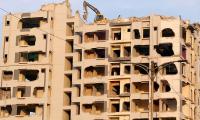The four-party agreement on Karachi — encompassing the PPP, MQM, PTI and NDMA — is a welcome development. Reportedly, the agreement is limited to ‘cleaning up’ the drains and the streets.
Solid waste management is a science: from collection to disposal to treatment. Waste is generated every day and its collection and disposal cannot be a onetime affair for the cameras. The quartet will need to address this institutional aspect, which is critical for any degree of success in improving city conditions. Otherwise, if garbage begins to accumulate again after the high-profile ‘Operation Clean up’ is over, the parties will revert to exchanging blame.
Karachi’s decline has not occurred overnight; it is the result of nearly four decades of depredations. Karachi was an eminently liveable place and has seen the era of relatively orderly urbanization. PIB Colony, PECHS, Federal B Area, Nazimabad, North Nazimabad, and Sea View stand as testimonies to planned development. Of course, all these areas are now distorted on account of illegal constructions. New areas have been developed sans any meaningful planning.
The disarray set in with Pakistan’s entanglement in the Afghan war in the 1980s, which saw all kinds of mafias taking control of land, water and public transport sectors and effectively determining governance standards of the city. The fragmented writ of the state in the city, with no one agency — elected or nominated — in command over the entire geographical space is also a key determining factor in perpetuating urban anarchy.
There are five most essential services that have to be provided: water supply, waste water disposal, solid waste disposal, electricity, and public transport. These services cannot be obtained privately by individual households and firms and have to be provided collectively by the city. All the five services are integrated and the common thread for efficient services delivery is the built environment — above and below ground.
Structures above ground are serviced by structures below ground. If below ground infrastructure is designed for a certain density and if the above ground density multiplies manifold without expansion of the below ground facilities, turmoil is the inevitable result. Karachi’s urban developers have violated the laws of gravity and the basic laws of urban and environmental planning. Unplanned and illegal construction, including uncoordinated coastal land reclamation, and density distortion is the crux of the city’s problems, particularly with respect to water supply and sewage disposal, post-rain flooding, traffic, and electricity supply.
There are two areas of Karachi’s civic management that need to be addressed institutionally: water and sewerage and public transport. Water and sewerage is managed by the KWSB, which is a hybrid provincial-municipal body. Clarifying its legal and functional jurisdiction is essential. This is because Karachi’s water sources lie outside its municipal area, while its water consumers are within. One solution could be to split the KWSB into two entities: one responsible for bulk water supply and the other for retail distribution. The former can be a provincial body and the latter a municipal body.
One major problem with the KWSB is failure to collect bills. Theoretically, utility supply can be cut off on account of non-payment. For obvious reasons, however, this cannot be done with water. One solution again could be to send consumers a consolidated bill for water, electricity and gas, with proceeds distributed among the three entities. Non-payment of bills can result in suspension of electricity supply.
The Karachi Circular Railway is a major public transport infrastructure, with efforts to revive the facility subject to turf battles between federal and provincial governments and constituency interests of political parties. Part of the rail track ‘right of way’ belongs to the federal government and part of it to the provincial government. The population inhabiting katchi abadis encroaching on rail tracks and stations is the vote bank of political parties, who have resisted their removal. The coalescing of all stakeholders offers the opportunity to sort out the competing interests and revive the facility.
One option could be to form a Karachi Circular Railway Company, with joint ownership of the federal, provincial and municipal entities and with the company in ownership and control of all lands and structures within its territorial jurisdiction. Funding has remained an intractable issue. However, constructing a high rise office block or shopping mall over two or three stations and the income from there can cover the cost, including the recurrent cost, of the project.
A number of solutions to Karachi’s civic problems are available and have been on the table for some time. The quartet has the opportunity to make a lasting difference to the lives of the residents of the city.
The writer was adviser for planning and development to the Sindh chief minister over 2010-11 and had presented reform proposals on some of the lines outlined in this article.
A representational image showing residents walking at a wholesale market in Karachi. — AFP/FileOnce again there is...
A representational image showing late Pakistani human rights activist and Supreme Court lawyer Asma Jahangir. —...
A representational image showing a security personnel sanding guard beside a ship carrying containers at Gwadar port....
A health worker administers polio vaccine drops to a child during a door-to-door polio vaccination campaign in Lahore,...
Armed militants of the banned Tehreek-e-Taliban Pakistan pose for a photograph in Orakzai Agency. —...
An aeroplane of the national flag carrier of Pakistan is seen in this file photo. — AFPWhile Pakistan considers...







